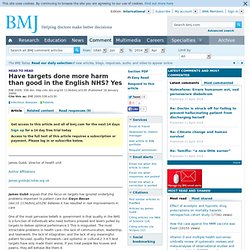

Muscles That Act On The Anterior Wrist and Hand. Surgical-tutor.org.uk - a free online surgical resource. Dr Foster Intelligence - Using the power of information to provide better services. Have targets done more harm than good in the English NHS? No. Gwyn Bevan, professor of management science Author Affiliations G.Bevan@lse.ac.uk James Gubb (doi:10.1136/bmj.a3130) argues that the focus on targets has ignored underlying problems important to patient care but Gwyn Bevan believes it has resulted in real improvements in care John Major’s government introduced targets as standards for hospital waiting times and ambulance response times to emergency calls in 1991 as part of The Patient’s Charter.1 The regime of star ratings provided a test of the efficacy of taking targets seriously.
The regime applied to NHS organisations in England from 2001 to 20052 and was unusual because it rewarded success and penalised failure in a process of naming and shaming. Have targets done more harm than good in the English NHS? Yes. James Gubb argues that the focus on targets has ignored underlying problems important to patient care but Gwyn Bevan (doi:10.1136/bmj.a3129) believes it has resulted in real improvements in care One of the most pervasive beliefs in government is that quality in the NHS is a function of individuals who need buttons pressed and levers pulled by targets to deliver optimal performance.1 This is misguided.

The most intractable problems in health care—the lack of communication, leadership, and teamwork; the lack of integration; and the lack of any meaningful, patient focused, quality framework—are systemic or cultural.2 3 4 5 And targets have only made them worse. If you treat people like knaves and pawns, they will behave like them.6 Perhaps the most influential management revolution of the past century was led by Taiichi Ohno at Toyota.7 Systems or “lean” thinking saw Toyota become the world leader in manufacturing; applied to health care it is again showing the way.
Septic Arthritis. Septic arthritis is an infection in a joint.

Many different types of germs (bacteria) can cause septic arthritis. Infection with a bacterium called Staphylococcus aureus is the most common cause. If some germs (bacteria) settle on a small section of a joint, they can multiply and cause infection. Bacteria can get to a joint: Via the bloodstream. Anyone at any age can develop septic arthritis. Have certain types of arthritis such as rheumatoid arthritis. The knee is the site of infection in more than half of cases. Pain from the affected joint. In most cases of septic arthritis the symptoms develop quickly, within a few days. Tests to confirm the diagnosis If you have typical symptoms coming from a joint near to the skin surface then the diagnosis may be fairly clear. A plain X-ray is not so useful to diagnose the early stages of septic arthritis.
Tests to find which germ (bacterium) is causing the infection The blood often contains some bacteria from the infected joint. Osteoarthritis. Arthritis means inflammation of the joints.

Osteoarthritis (OA) is the most common form of arthritis in the UK. OA mainly affects the joint cartilage and the bone tissue next to the cartilage. A joint is the term for where two bones meet. Joints allow movement and flexibility of various parts of the body. The movement of the bones is caused by muscles which pull on tendons that are attached to bone. Cartilage is a hard, smooth tissue that covers the end of bones.